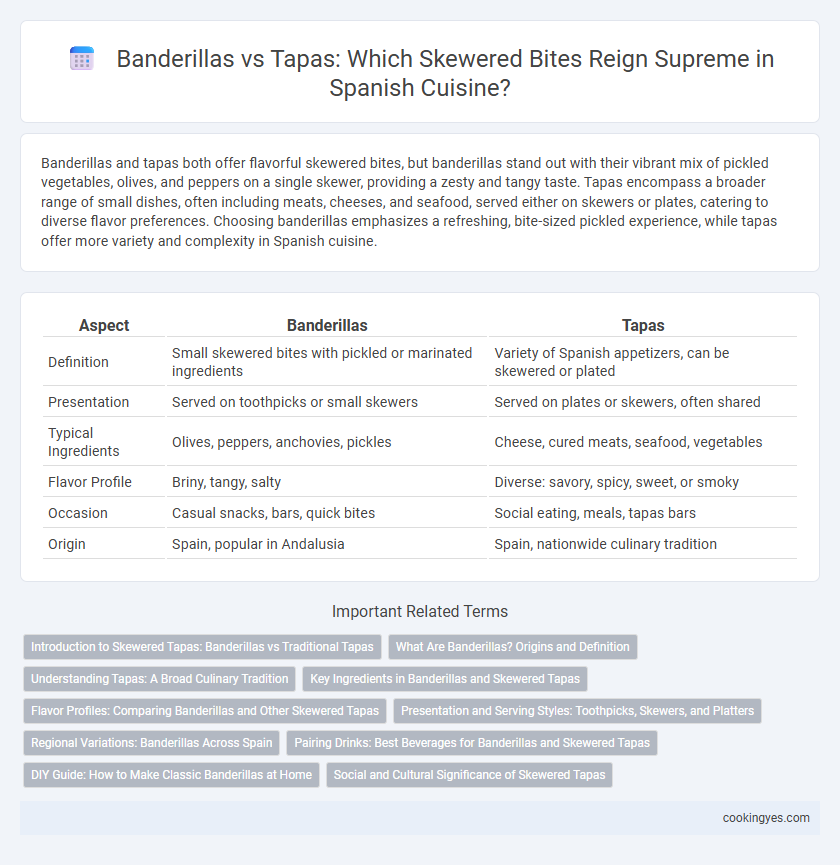Banderillas and tapas both offer flavorful skewered bites, but banderillas stand out with their vibrant mix of pickled vegetables, olives, and peppers on a single skewer, providing a zesty and tangy taste. Tapas encompass a broader range of small dishes, often including meats, cheeses, and seafood, served either on skewers or plates, catering to diverse flavor preferences. Choosing banderillas emphasizes a refreshing, bite-sized pickled experience, while tapas offer more variety and complexity in Spanish cuisine.
Table of Comparison
| Aspect | Banderillas | Tapas |
|---|---|---|
| Definition | Small skewered bites with pickled or marinated ingredients | Variety of Spanish appetizers, can be skewered or plated |
| Presentation | Served on toothpicks or small skewers | Served on plates or skewers, often shared |
| Typical Ingredients | Olives, peppers, anchovies, pickles | Cheese, cured meats, seafood, vegetables |
| Flavor Profile | Briny, tangy, salty | Diverse: savory, spicy, sweet, or smoky |
| Occasion | Casual snacks, bars, quick bites | Social eating, meals, tapas bars |
| Origin | Spain, popular in Andalusia | Spain, nationwide culinary tradition |
Introduction to Skewered Tapas: Banderillas vs Traditional Tapas
Banderillas are distinctive Spanish skewered tapas featuring a vibrant combination of olives, pickles, peppers, and anchovies threaded on small sticks, offering a burst of tangy and savory flavors. Traditional tapas skewered bites vary widely but often include grilled meats, seafood, or vegetables, emphasizing smoky and robust tastes that highlight regional culinary diversity. Both Banderillas and traditional skewered tapas serve as popular appetizers, showcasing Spain's rich gastronomic culture through their unique presentations and ingredient contrasts.
What Are Banderillas? Origins and Definition
Banderillas are traditional Spanish skewered bites typically consisting of pickled vegetables, olives, and anchovies, often served as a cold appetizer. Originating from Andalusia, the name "banderillas" refers to the colorful barbed sticks used in bullfighting, reflecting the vibrant and varied ingredients threaded onto the skewer. Unlike broader tapas, banderillas specifically emphasize a balanced combination of salty, tangy, and savory flavors in a convenient, bite-sized form.
Understanding Tapas: A Broad Culinary Tradition
Banderillas are a specific type of tapa characterized by skewered bites typically combining olives, pickles, and anchovies, reflecting a distinct presentation within the broader tapas category. Tapas represent a diverse range of Spanish small dishes, encompassing cold and hot preparations that vary regionally in ingredients and style. Understanding tapas as a culinary tradition reveals their role in social dining, emphasizing sharing and variety beyond the singular skewer format of banderillas.
Key Ingredients in Banderillas and Skewered Tapas
Banderillas are typically composed of pickled elements such as olives, gherkins, pearl onions, and anchovies skewered together for a tangy and briny flavor profile. Skewered tapas often feature a broader range of key ingredients including chorizo, grilled vegetables, seafood like shrimp or squid, and manchego cheese, offering a more diverse taste experience. Both rely on the art of balancing textures and flavors, with banderillas emphasizing vinegary sharpness while skewered tapas showcase savory and smoky notes.
Flavor Profiles: Comparing Banderillas and Other Skewered Tapas
Banderillas feature vibrant combinations of pickled vegetables, olives, and cured meats, delivering a tangy, briny flavor profile that distinguishes them from other skewered tapas. Traditional tapas skewers often emphasize grilled or marinated meats and seafood, offering smoky, savory, and herb-infused tastes. The contrast between the sharp acidity of banderillas and the rich, robust flavors of grilled skewers creates diverse options appealing to varied palates in Spanish cuisine.
Presentation and Serving Styles: Toothpicks, Skewers, and Platters
Banderillas are typically served on wooden skewers or toothpicks, offering a colorful, bite-sized presentation often arranged on long platters for easy sharing at bars or parties. Tapas, while sometimes incorporating skewered items, usually come in a variety of serving styles including small plates or bowls, emphasizing a casual yet diverse dining experience. The use of toothpicks in banderillas highlights portability and finger food appeal, whereas tapas plating focuses on variety and complementing different flavors.
Regional Variations: Banderillas Across Spain
Banderillas are a distinctive type of skewered bite commonly found in Andalusia, characterized by their colorful combination of pickled vegetables, olives, and anchovies, contrasting with the broader category of tapas that varies widely across Spain. In Madrid and Castile-La Mancha, banderillas often include local specialties like guindillas and cured meats, reflecting regional tastes and ingredients. This regional diversity highlights how banderillas serve as a microcosm of Spain's culinary landscape, offering a snapshot of local flavors within the popular tapas tradition.
Pairing Drinks: Best Beverages for Banderillas and Skewered Tapas
Banderillas, typically featuring a medley of olives, pickles, and anchovies on skewers, pair exceptionally well with dry sherries like Fino or Manzanilla, enhancing their briny and tangy flavors. Skewered tapas, which may include grilled meats or vegetables, complement robust red wines such as Tempranillo or Garnacha, offering a rich counterpoint to smoky and savory bites. Beer styles like light lagers or crisp pilsners also harmonize with both banderillas and skewered tapas, providing refreshing balance to the salty and spiced profiles.
DIY Guide: How to Make Classic Banderillas at Home
Banderillas are a distinctive type of tapa featuring colorful skewered bites of olives, peppers, and pickled vegetables, making them visually appealing and flavorful. To make classic banderillas at home, start by threading ingredients such as green olives, pickled onions, anchovies, and guindilla peppers onto small wooden skewers. Marinate the assembled skewers in a mixture of vinegar, olive oil, and spices to enhance the tangy and savory flavors characteristic of this popular Spanish snack.
Social and Cultural Significance of Skewered Tapas
Banderillas and tapas both highlight the social and cultural significance of skewered bites in Spanish cuisine, offering a visual feast that encourages communal dining and conversation. Banderillas, typically small skewers adorned with olives, peppers, and anchovies, symbolize festive gatherings and tapas culture's emphasis on variety and sharing. Tapas skewers, ranging from meats to vegetables, reflect regional diversity and Spain's deep-rooted tradition of enjoying food as a social experience.
Banderillas vs Tapas for skewered bites Infographic

 cookingyes.com
cookingyes.com